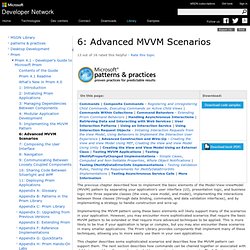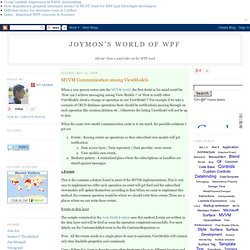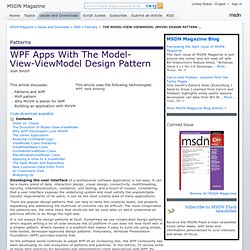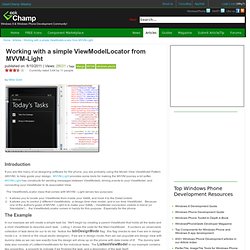

6: Advanced MVVM Scenarios. The previous chapter described how to implement the basic elements of the Model-View-ViewModel (MVVM) pattern by separating your application's user interface (UI), presentation logic, and business logic into three separate classes (the view, view model, and model), implementing the interactions between those classes (through data binding, commands, and data validation interfaces), and by implementing a strategy to handle construction and wire-up.

Implementing the MVVM pattern using these basic elements will likely support many of the scenarios in your application. However, you may encounter more sophisticated scenarios that require the basic MVVM pattern to be extended or that require more advanced techniques to be applied. This is more likely to be true if your application is large or complex, but you may also encounter these scenarios in many smaller applications. C# - WPF MVVM Modal Overlay Dialog only over a View (not Window) Custom popup and windows in WPF the MVVM way. In WPF, using the regular window control to launch child windows makes MVVM and separating a View concern from the ViewModel very difficult.

The problem: The window control works nicely as a shell for your application, however, launching child windows is problematic because the window control cannot be defined in xaml unless as the root element. So, if you wanted to launch child windows inside a parent window, you lose the ability to declare these in xaml. This loss means you will not be able to bind to properties in your ViewModel from the view for the purpose of opening/closing a window.
Instead you end up doing this imperatively in code which means more code, more thought, more work. Following is what you end up doing in the most minimalistic cases. MyWindow window = new MyWindow(); window.ShowDialog(); Adding code such as the above means you are forced to make your ViewModel create instances of your Window and launch them when needed. <ResourceDictionary.
MVVM Communication among ViewModels. When a new person enters into the MVVM world ,the first doubt in his mind would be ‘How can I achieve messaging among View-Models ?

’or ‘How to notify other ViewModels about a change or operation in one ViewModel ?’ For example if we take a scenario of CRUD database operations there should be notifications passing through on each operation like creation,deletion etc...Otherwise the listing ViewModel will not be up to date. When the same view-model communication came in to my mind, the possible solutions I got are Events : Raising events on operations so that subscribed view models will get notification. Data access layer / Data repository / Data provider owns events View models own events. 1.Events Events at data layer. THE MODEL-VIEW-VIEWMODEL (MVVM) DESIGN PATTERN FOR WPF. Patterns WPF Apps With The Model-View-ViewModel Design Pattern Josh Smith Developing the user interface of a professional software application is not easy.

It can be a murky blend of data, interaction design, visual design, connectivity, multithreading, security, internationalization, validation, unit testing, and a touch of voodoo. Considering that a user interface exposes the underlying system and must satisfy the unpredictable stylistic requirements of its users, it can be the most volatile area of many applications. There are popular design patterns that can help to tame this unwieldy beast, but properly separating and addressing the multitude of concerns can be difficult. It is not always the design patterns at fault. As the software world continues to adopt WPF at an increasing rate, the WPF community has been developing its own ecosystem of patterns and practices.
Order vs. It is unnecessary and counterproductive to use design patterns in a simple "Hello, World! " Figure 1 Workspaces.
Simple ViewModel Locator for MVVM: The Patients Have Left the Asylum - John Papa. I’ve been toying with some ideas for MVVM lately.

Along the way I have been dragging some friends like Glenn Block and Ward Bell along for the ride. Now, normally its not so bad, but when I get an idea in my head to challenge everything I can be “interesting” to work with :). These guys are great and I highly encourage you all to get your own personal Glenn and Ward bobble head dolls for your home. But back to MVVM … I’ve been exploring the world of View first again. The idea is simple: the View is created, and it creates the ViewModel in the View’s XAML. I started talking to Glenn Block about how to use MEF to make the ViewModel locator completely generic. Here are the steps (after you reference the DLL with the ViewModelLocator): STEP 1: Create the ViewModelLocator in App.xaml as a Static Resource So what I really wanted was to be able to easily crank up ViewModels.
Notice I create a converter too. Working with a simple ViewModelLocator from MVVM-Light. <phone:PhoneApplicationPage x:Class="ItemList.MainPage" xmlns:phone="clr-namespace:Microsoft.Phone.Controls;assembly=Microsoft.Phone" xmlns:shell="clr-namespace:Microsoft.Phone.Shell;assembly=Microsoft.Phone" xmlns:MVVM="clr-namespace:ItemList.ViewModelLocator.Framework.Implementors.Silverlight.MVVM" mc:Ignorable="d" FontFamily="{StaticResource PhoneFontFamilyNormal}" FontSize="{StaticResource PhoneFontSizeNormal}" Foreground="{StaticResource PhoneForegroundBrush}"

MVVM Animation by DataTrigger.